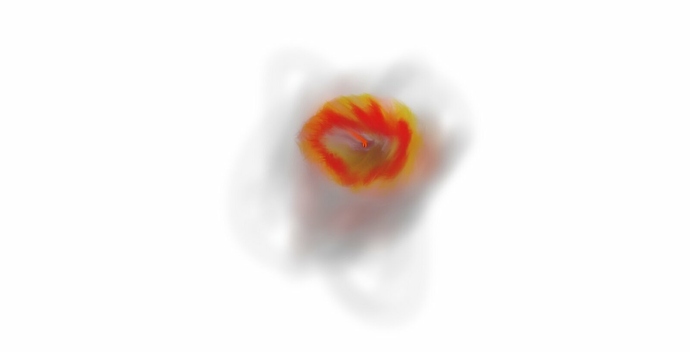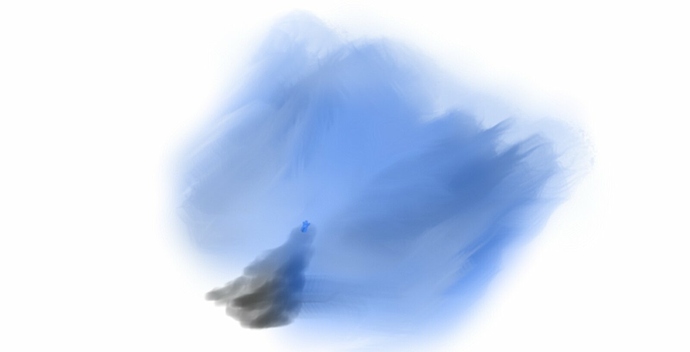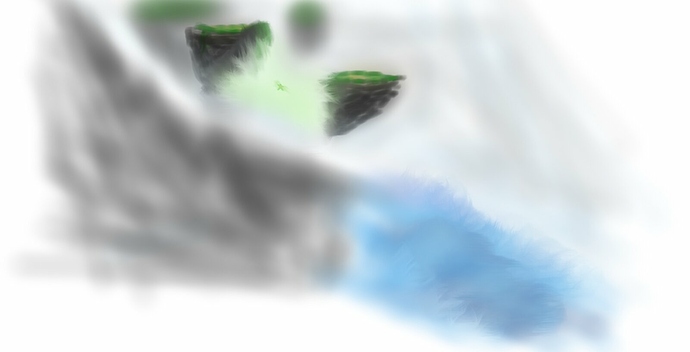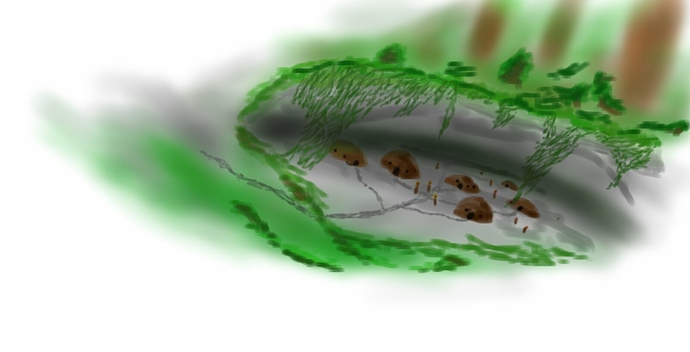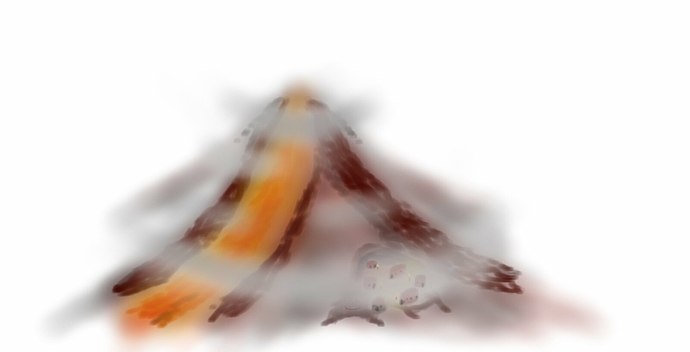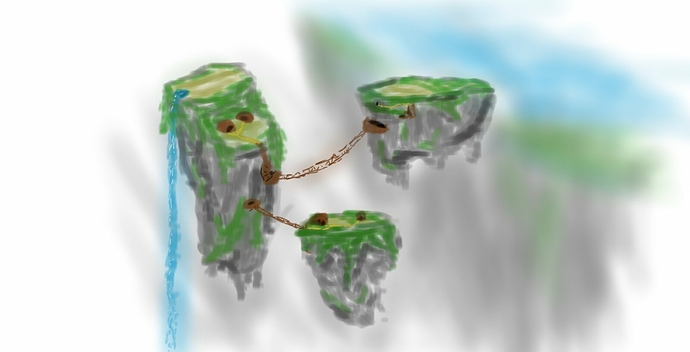So, listening to the latest podcast, and considering many different ideas, I have finally got something to say of value in this discussion.
I have spent some (far too much) time considering what a potential G3 could look like, and should look like, and so, you’ll find below, my ideas. I have structured it with a section on Characters, Worldbuilding and Plot for each year, and I will come back and add Set Ideas at a later date, as well as concept images and such.
Here is what I imagine the world looking like:
And remember, I have thought about this as something which I would enjoy. Feel free to disagree, and please leave comments and constructive criticism below!
Year 1:
Characters:
Tahu. As discussed on the podcast, Tahu remains more or less the same. He is reckless (but not to the point of silliness, more like the G1 portrayal) but loyal. Has a temper. He is the Toa of Fire, and controls heat and flame in the same way. He prefers direct outbursts and displays of power over subtlety.
Gali. The cool and calm Toa of Water. She is slightly more defined as the intellectual of the group, and is much more patient. She controls water, ice, and vapour, and she prefers direct water techniques, and healing abilities.
Onua. Toa of Earth, he is wise and listens to nature. He is perhaps not as intelligent as Gali, but listens and considers everything. He controls the newly defined element of Earth, being in tune with nature. He exerts a subtle control, not dominating his element, but working with it. He doesn’t demand, he suggests. His prefered fighting style is the subtle manipulation of terrain - he can turn the enemy’s footing to slosh, ensnare them in vines and such.
Lewa. He remains as the Toa of Air (come on, wind sounds dumb). His powers largely remain the same as in G1, and he has the ability to fly. He is definitely the jokester, he is funloving and appears younger than the others. His prefered fighting style is loose and dexterous. He relies on agility and outmaneuvering his opponent.
Turaga. There are turaga/elder figures in each village, who know much, and are far less annoyingly cryptic than the originals.
Tohunga/Matoran. There are villagers as well, and while their characters aren’t central to the main plot, they can be developed in surrounding material.
The Makuta. The big bad, he lives beyond the world, and works to enslave the villagers for his projects. Not much is known, other than his followers come from over the precipice.
Mata Nui? I don’t think he is necessary. It is nice to have the brotherhood paralleled, and perhaps he could still exist, but perhaps as the first victim of the Makuta. He is entombed in the centre of the island, and revered by all.
World:
The story is set on an island (honestly okoto isn’t a bad name, but if Mata Nui doesn’t exist as a character, then the island can be Mata Nui. I shall call it so throughout), which sits on the edge of existence. The oceans pour into the void over the edge on the west of the island. There is another land mass to the East, and nothing but open air to the west.
The North coast and northern area of the island is distinctively water and ice. This is Ga-wahi (or whichever term we decide, I like the old ones, and they were never confusing as a child, so I’ll go with those), and the coast houses Ga-koro. A stilt village, it is a peaceful place of fishing and meditation. Think early G2 art. Something like this:
The west coast is covered in lush jungle. This is onu-wahi. There is a village which straddles the underground and jungle huts, with a very earthy and solid feel. Hence, Onu-koro.
To the south is ta-wahi. A volcano in the southern half of the island pours lava down the region, to where it spills off the edge near the water from the oceans.
And finally, to the East is Le-wahi. Existing partially over the edge, it is a series of floating islands, which move gently throughout the seasons. There are rope bridges and vines spanning them, and draped down the sides. Le-koro is spread across several islands, and birds are kept, ridden, and lived with in this area. Maybe gliders/airships?
Tying this all together is a rocky formation which separates the regions and culminated in a huge mountain in the middle, on top of which is the tomb of Mata nui/some other macguffin.
The Plot:
First half of the year: Establish setting and characters. The Makuta has sent the 'Fikou’ - a race of spider like beings which came scuttling over the edge recently, and now infest the island. I apparently can’t draw characters, but this is the basic concept:
The villagers are too scared to leave the safety of their towns, until ancient warriors appeared, seemingly formed from their elements, and fought the creatures back.
The turaga inform them of the masks of power - macguffins which contain enough elemental energy to protect the villagers without the Toa’s help. The collectible hunt is on!
The Toa fight the fikou, meet one other, and retrieve some of these ‘kanohi.’ These can only be used for a short time by villagers before it burns them out, but they temporarily gain the powers of their elements, in a similar way to the Toa.
Second half of the year Fighting back. With the retrieval of so many Kanohi, the Toa and powered up villagers fight alongside one another, and drive the fikou from the island. With a final, climactic battle in ta-wahi, it is revealed that The Makuta has plans for the entire world, not just the island, and that the Toa are not unique. With the villagers now able to handle themselves against the Fikou, the turaga send the toa off to find more, and learn about their origin.
Second Year:
Characters:
Toa. Same as last year, with some character growth, and some power honing. This would be developed through the first year. Perhaps a change of armour, although not a 'power up,’ more of an adaptation to a new environment.
The Makuta. Much the same. Mysterious, everpresent, and manipulative. Tests each of the Toa in turn, stressing their Character and spirit throughout the year.
Kopaka and Pohatu. Think back to the banter and friendship between the two in the C. A. Hapka novels. This.
Kopaka is a Toa of Water, but where Gali primarily focuses on healing and direct water content, Kopaka is ice-focussed, and prefers an offensive style. He is cold and calculating, a foil for Pohatu.
Pohatu is another Toa of Earth. Much like Kopaka and Gali, he focusses on the physical portion of Earth, as opposed to Onua. He is much more dominating over his element, and is physically very strong. He prefers force to subtlety. Once more, he is similar to his G1 version in that he is lighthearted and friendly.
HOWEVER! Both Kopaka and Pohatu used to be a part of another full Toa team. The other two were brutally killed by the Makuta, and Kopaka and Pohatu now wander their continent trying to assist in the fight, but haunted by their failure. Kopaka was the leader of this team, and the loss of his sisters drove him to his bitter and withdrawn state, while Pohatu uses his jokes and friendliness as a mask for his pain. They are very close, and their friendly banter is unique, as neither relate well to the new Toa.
Villagers. This new continent used to have numerous villages, but the attacks of the Makuta have driven it to a desolate state. The few remaining villagers were forced to mobilise or be obliterated, and so now travel in convoys of scrap vehicles (pretty much think mad Max Style).
World:
The four main Toa have travelled to the continent to the west. It is windblown and devastated by conflict. There are burnt forests, open sunbaked plains, and huge, crystalline glass surfaces, blasted into existence throughout the war. Across these areas travel convoys of villagers, and huge swarms of Bohrok - stumpy creatures, of low intelligence, they are deadly in numbers, wielding esoteric powers (gravity, magnetism/metals, sonics, and one other. I’m not happy with telekinesis, but it’s the best one i can think of this late at night).
The Plot:
First half of the year: The Toa arrive on the larger continent, and meet Kopaka and Pohatu. They struggle to get along, but manage. They are introduced to the Bohrok, who, by virtue of their powers (I have specifically designed them as over powered. These are bad guys the Toa can’t just face head-on. This is why Kopaka and Pohatu haven’t been able to beat them, and why the other two Toa were killed). At some point, Pohatu and Kopaka relate their story, and they all meet up with some villagers.
They travel further inland, in hopes of finding the Bohrok 'nest’ and permanently stopping them. They find the nest, but find no way to completely stop the Bohrok. They can stop more from being made, and in the process discover a way to the Makuta’s lair. They decide, however, that they must get back to the island first.
Second half of the year: All six Toa fight a mad Max Style battle across the deserts and glass plains back to the eastern coast. They grow in power, as do Pohatu and Kopaka, with the latter becoming a very powerful team. At the coast, the original Toa depart for the island, leaving Pohatu and Kopaka fighting a rearguard, determined to take the fight to the Makuta. The Toa return to their island, searching for answers.
Final Year:
Characters:
Toa. Once again, more powerful and more matured from their previous year, which was shown throughout.
Villagers. Several villagers have distinguished themselves in combat, forming a 'chronicler’s company,’ (e.g. Jala, Hahli, Nuparu and Kongu), perhaps in a side plot running concurrent to last year?
The Makuta. Manipulating, controlling, etc.
World:
We return to the island. Over the last year the Fikou have been completely eliminated, and the villagers are rebuilding and working together once more. There is more of a focus on Le-wahi, with the foreshadowing of a dark mist from below.
The Plot:
The villagers have discovered a secret chamber within the central mountain, which takes all four Toa to open. The four Toa all face personal challenges and tests inside, and then face trials as a team, testing their unity, and their sense of duty. Finally they are presented with answers: it is revealed that they were created by the Makuta as a means to draw the villagers away from their villages. The spread out villagers cannot protect the shrine in each village, housing elemental macguffins. This is what happened on Pohatu and Kopaka’s continent, and while the Toa are in this lab, the villages have all been attacked. Insect-like creatures known as Rahkshi, with personal powers and effects (fear, anger, despair, etc) have torn the villagers apart.
Those at the scene are dead, along with the turaga, and those elsewhere have been affected by these powers. The Toa face their own demons, as the unwitting instruments of this defeat, but are inspired by the Chronicler’s Company’s courage in the face of defeat, and resolve to fight on and right this wrong. The Toa hunt the Rahkshi relentlessly, and watch them leap off the edge of the world, into the void. They look back at the burning island, and resolve to never return until they have defeated the Makuta, and leap off the edge together…
Finale - Over the Precipice: The Toa find themselves in a graveyard, of sorts. Imagine a sick, twisted workshop, where the tinkerer was creating beings of death, and sending them forth. There are discarded parts of Fikou, Bohrok, Rahkshi, and other, more horrible creatures strewn across the floor. The workshop is also huge, and densely wrapped in shadow. Only the faintest of light filters in from above.
The Rahkshi ambush the Toa, but their combined resolve resists the dividing nature of the Rahkshi’s powers. The Toa move on, into the labyrinth of shadow. Pitch-black, with Tahu’s flames only illuminating small areas, the Toa face shadow versions of themselves. This is what the Toa could have become, had they turned to the Makuta. Upon making peace with their darker sides, each Toa becomes one with the Shadow Toa, and move on.
They come across Pohatu and Kopaka - grim faced warriors, fuelled by vengeance and determination, still fighting their way towards the Makuta. They assist them in defeating the last of the Bohrok, and they all continue towards the final chamber.
Ending 1: The Toa enter a huge antichamber, with magma spilling down the sides and through intricately carved patterns in the floor, and are confronted with tens of other Toa, all seemingly stood in a similar situation. The doors crash shut, and shadow wraps itself around d the magma. Two red eyes open, and deep laughter is heard as the screen fades to black. - I like this ending because it leaves it open, but also neatly rounds off the arc. It leaves questions, but also presents the ability for a conclusion in the imagination. It does lack closure, however, and so, we move on to the more cliche second ending:
Ending 2: The Toa enter the room as above, sans the other Toa, and find a small grey villager stood upon a dais in the centre. In a mnog style, he reveals himself as the Makuta, and goes on to become shadow and give the Toa a good thrashing. In the midst of this, at a crucial moment, Pohatu sacrifices himself to save Kopaka and allow the others to defeat the Makuta. (Kopaka also retrieves Pohatu’s armour/helmet and uses it himself as a memorial). The group, now five and a body, return to the surface through a vast labyrinthine tunnel system, returning them to where the Fikou first appeared.
With the Rahkshi gone, the Chronicler’s Company could reunite the villagers, and a bittersweet victory was achieved. It ends hopefully, with the villagers rebuilding, and Kopaka bringing the remaining villagers from the other continent across to the island. Kopaka particularly is affected by Pohatu’s sacrifice, and adopts some of his personality traits, although they all feel the impact of his death. - this ending offers closure, but it also closes the story. It is hard to continue it without it feeling forced. However, it also demonstrates the cost of victory, and the consequences. And above all, it ends with hope, and an idea for a future.
So, overall, those are my thoughts on G3. Honestly, this is a story I would read, a setting I would find interesting, and characters I would grow attached to. It’s a bit darker than your average Lego theme, but then, I always found that a sense of consequence lends itself to Bionicle well. I have strived to balance G1 nostalgia with new story and new ideas, and to create an interesting world for this to exist in.
Make sure to leave your thoughts and criticisms below!

